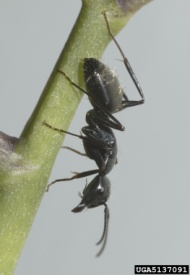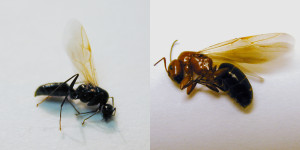General Information
 Carpenter ants play an important role as decomposers of decaying trees; however, in some areas of the country can be damaging to structures. Unlike termites, carpenter ants do not feed on wood; they simply nest there. Wood is damaged as these ants construct smooth “galleries” with rounded edges, excavated in softer parts of wood building elements. Galleries tend to follow the grain of the wood with passages that cross harder wood. Many species of carpenter ants, especially in the southern U.S., do little structural damage; however they can become a nuisance when they nest indoors in insulation or other void areas in walls, doors, etc. The most damaging species are found in the Pacific northwest, upper midwest, and northeastern states.
Carpenter ants play an important role as decomposers of decaying trees; however, in some areas of the country can be damaging to structures. Unlike termites, carpenter ants do not feed on wood; they simply nest there. Wood is damaged as these ants construct smooth “galleries” with rounded edges, excavated in softer parts of wood building elements. Galleries tend to follow the grain of the wood with passages that cross harder wood. Many species of carpenter ants, especially in the southern U.S., do little structural damage; however they can become a nuisance when they nest indoors in insulation or other void areas in walls, doors, etc. The most damaging species are found in the Pacific northwest, upper midwest, and northeastern states.
- Water-damaged or other softened wood is especially conducive to nesting, with gallery expansion into adjacent sound wood as the colony grows. Nests may also be constructed in wall voids, insulation, hollow doors, or wood furnishings or fixtures.
- Carpenter ant nests are kept clean, with frass, sawdust-like wood shavings, dead ants, and other debris pushed out of the gallery through a crack or slit, creating telltale dump piles that look like sawdust from a distance.
- Carpenter ants will eat fruit, insects, meat, and sugars including insect honeydew. Carpenter ants typically forage in late afternoon and night, up to 200 yards from the nest, and carry food back to the colony.
Identification

Male (left) and female carpenter ant swarmers. Note the pinched waist that distinguishes these insects from termites.
Swarms of winged carpenter ant reproductives will emerge inside a building structure, occasionally. Carpenter ant swarms usually occur in the spring and are a sure sign that a colony is nesting somewhere inside the structure.
Carpenter ants’ range in size from ¼ – ½ inch (7-15 mm) long with a single node between the abdomen and evenly rounded, spineless thorax. Color variations include black, red, red and black, or brown. Colonies will produce winged reproductives or swarmers. Male reproductives die after the female is mated and begins to form a new colony.
Suggested Thresholds
First sign of ant trails consisting of 10 or more ants. When winged (reproductive) ants are present indoors, a nest may be present and treatment should be initiated following an inspection. However, the IPM technician should be consulted to ensure that such insects are not confused with termites.
Monitoring and Inspection
Carpenter ants forage outside the nest for food and water and are often sighted in infested dwellings around sinks or bathroom fixtures, especially in late winter and spring. Foraging ants can sometimes be followed to locate the nest, which may be outside of the structure. A parent nest is usually located outside the structure with satellite nests located inside. Finding the parent nest outside is recommended to prevent satellite nest formation indoors.
Sawdust-like waste piles are telltale signs of nesting activity. An awl, spatula or screwdriver can be used to probe for damaged wood. Thermal imaging can also be used to locate potential nests within a building.
Nonchemical Control Measures
Sanitation/Cultural Control Measures
- A primary defense against carpenter ants is to avoid moisture-damaged wood.
- Regularly inspect and promptly correct roof, window or vent leaks; clogged, damaged or improperly aligned gutters; or wood that may be in contact with soil or vegetation.
- Prune trees and shrubs in contact with the structure.
- Move firewood piles or other debris away from the structure.
- Decaying or softened wood building elements, such as soft decking and window or door sills, should be repaired or replaced.
- Vacuuming up ants, nests and debris can aid in quick removal of worker ants.
- Heat treatment and freezing are also potential controls but are rarely used, unless the article cannot take chemical treatments.
Physical/Mechanical Control Measures
- Repair any water leaks from roofs, windows, pipes or other sources.
- Remove tree stumps and landscape timbers adjacent to structures.
- Trim branches touching structures or wires leading to structures.
- Improve ventilation to speed drying in attics, crawlspaces and other enclosed areas.
Chemical Control Measures
Carpenter ant control can be difficult due to variation in bait acceptance among species and across seasons. Granular baits and gel baits specifically designed for carpenter ants should be placed in inaccessible areas reduce the potential for occupant exposure. For greatest impact, baits should be placed near ant trails. Baits may take up to 60 days to eliminate the colony. Replenish baits as needed until ants are no longer present. If ants do not appear to take a given bait, try a different brand or wait a few weeks and try again.
When the location of a carpenter ant nest is known, insecticides may be applied directly to the nest void. Applications can be made through a natural opening (i.e., frass kick hole) or through a hole made by drilling into the suspected nest cavity. Apply small amounts of an insecticide dust or aerosol labeled for indoor use into the nest opening. Where nests cannot be identified with certainty, dusts may be applied to voids reached by removing electrical outlets or switch plate covers, or by drilling holes wall voids and sealing after the application.
Broadcast spray applications should be the last option for carpenter ant control. Spray applications to building exteriors, and exposed impervious surfaces including foundations, walkways, and driveways are prone to runoff into surface water and should be avoided unless all other options have failed. Always read and follow the label. The label is the law. Pesticides must be used in accordance with federal, state and local regulations. Applicators must have proper credentials to apply pesticides and should always wear personal protective equipment (PPE) as required by the pesticide label during applications. All labels and Safety Data Sheets (SDS) for the pesticide products authorized for use in the IPM program should be maintained on file.
Evaluation Methods
Carpenter ant activity can be monitored before and after treatment to determine effectiveness of management efforts. Place honey, jelly, sugar in milk or previously frozen mealworms or crickets on cards/caps around the structure in the evening or late afternoon, where ants have been seen at potential water, food or nest sites. Leave in place for sufficient time for the ants to find the attractants and count the number of ants at each station.
